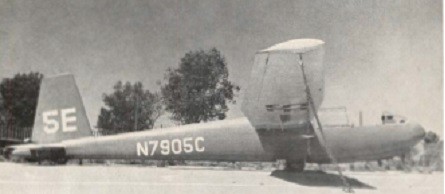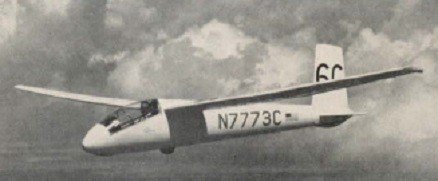Irving O. Prue
1964
about
(1915-2001) Sailplane Designer/Builder; U.S. Team Crew Chief 1958, 1960, 1962; World/National Records
Awards
Eaton Trophy 1966; Silver #381 1960; Gold #98 1960; Diamond #145 (Int #862) 1970
Bio

Well-known sailplane designer, Stan Hall, said about Irv Prue, "Whether other designers of the era were aware of it or not, Irv had a profound effect on how they carried out their designs. To my mind, every sailplane in the world carries his imprint."
Irv Prue first became interested in gliders when he read about the Germans' activities in a 1929 issue of the National Geographic Magazine. While still in high school, he constructed three primary gliders in which he learned to fly without instruction. Auto tow was the primary launch method, although a shock cord, devised of automobile tire inner tubes, was used in winter on the frozen Missouri River at Richfield, VT.

Irv moved West after completing high school to follow a career in aviation. He completed his studies in the Technical and Mechanical School of the Boeing School of Aeronautics and settled down in California. His first design after WW II was the diminutive Prue 160 whose fuselage was derived from a P-38 drop tank. The construction was entirely of magnesium, flush riveted, and incorporating a V-tail. It weighed 165 pounds.

Next followed the Prue 215. Again it was all-metal, flush riveted and included a reclining cockpit, an external airfoil flap and a retracting landing wheel. Irv chose aluminum as the material for this and his succeeding designs.

This was followed by the Prue Two in which he incorporated retractable landing wheel and added fiberglass to his structural design. In 1967 Ed Minghelli flew it to a world two-place goal-and-return record of 360 miles.

Next came the Prue Standard (for standard class competition) in which Paul Bikle set an unofficial world distance record of 557 miles in 1963 (he did not carry a barograph). It was this same sailplane that Paul invited moon-walker Neil Armstrong to fly at Inyokern, CA in 1963. Alex Aldott flew the Prue Super Standard for an Hungarian distance record of 465 miles in 1964. Irv went the entire route for this design by obtaining an FAA Type Certificate - probably the first (and likely only) individual to accomplish this task.
More words from Stan Hall: "There was genius here and we all knew it. Irv was a man to watch, and watch him we did. In fact, I did more than watch him; some years later I blatantly copied his technique for attaching the wings in my own designs. When I was active in designing aircraft for a living, I often found myself, when running into a design problem, thinking, 'How would Irv handle this one?' Unbeknown to him, he came to my rescue every time."
Irv was employed by Lockheed Martin Aeronautic Co. aerospace firm for 41 years. His projects included the Lockheed Electra models 10, 12, 14, 16 and 18; the P-38, F-80, F-94 and F-104; the Hercules cargo and Constellation passenger planes; and the Blackbird reconnaissance craft.
Stan Hall continues - "His self-imposed rule seemed to be: stay focused, never give up, find a way, and never let a little pain get in the way of your dreams. His sailplanes gave ample evidence that he followed this dictum with unrelenting fervor. No doubt, we could all profit from adhering to the example set by this remarkable human being. I know I am. He lives in me. He lives in US."
Irv Prue served as crew chief for U.S. Teams in three world competitions. He received the Eaton Trophy in 1966 and earned Silver #381 in 1960, Gold #98 in 1960 and Diamond #145 (Intl #862) in 1970.
Above adapted from Soaring magazine sources with photos (many by George Uveges) including "Portrait of Irv Prue" by Floyd Sweet (January 1968, page 20) and "The Story of the Prues" by Irv Prue (April, 1965, page 8).